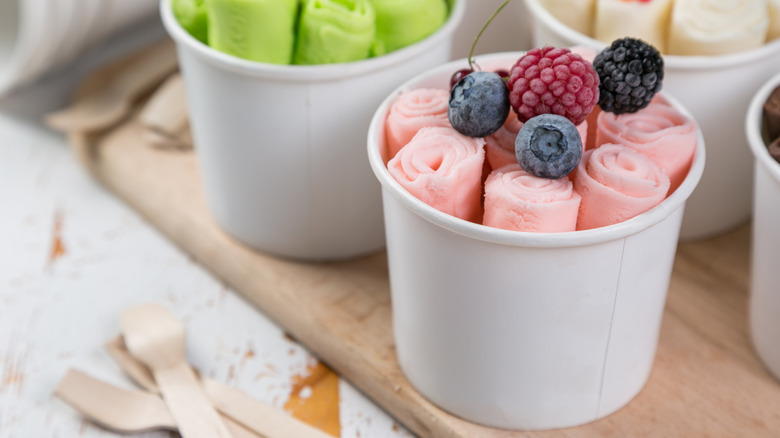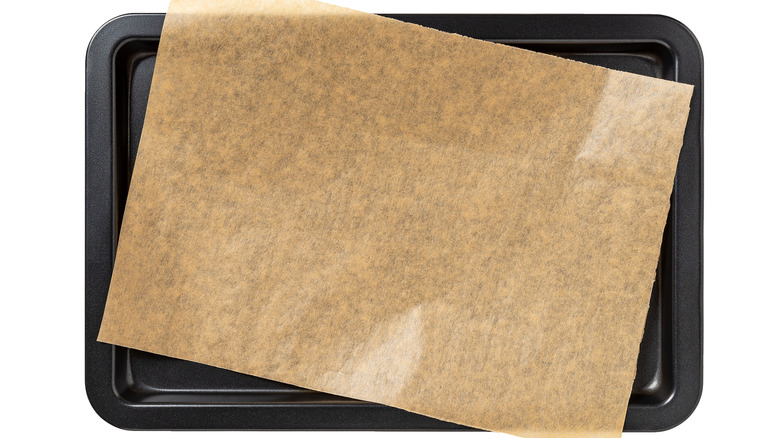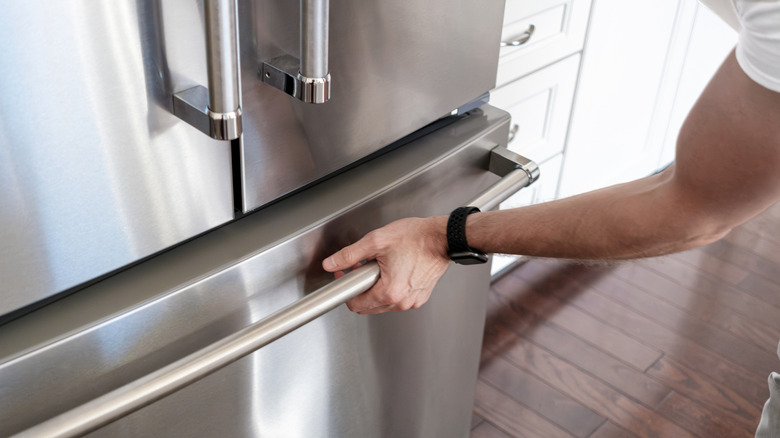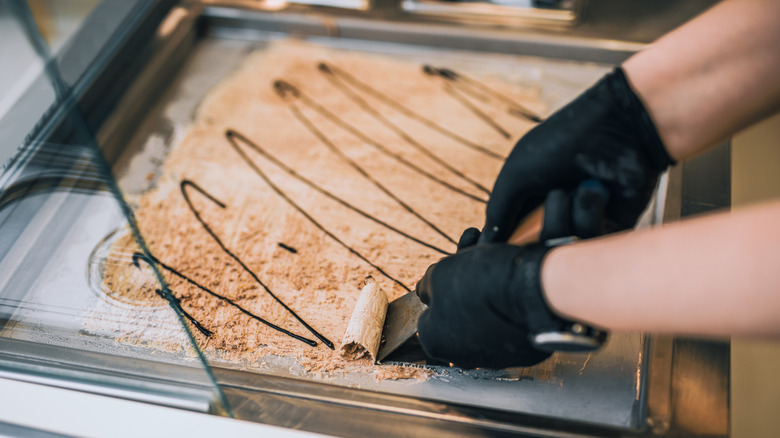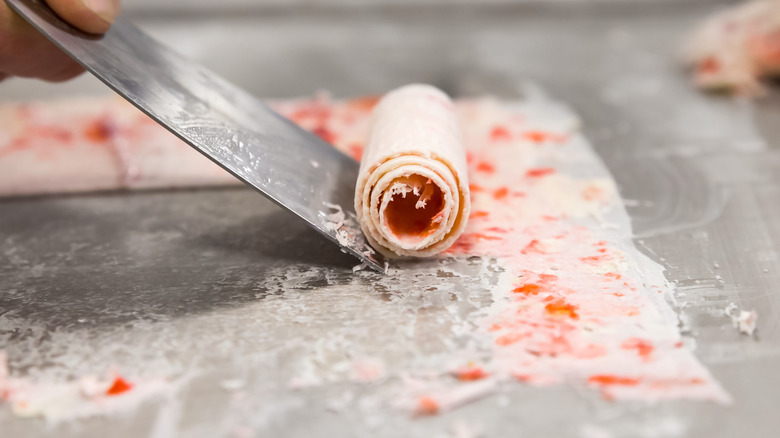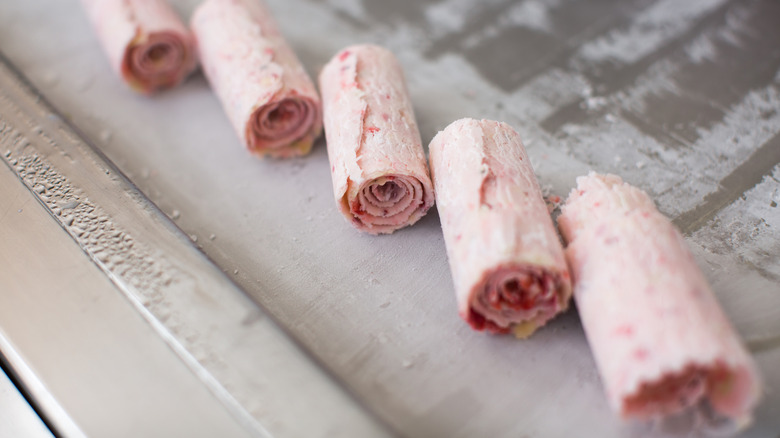6 Tips You Can't Ignore For Homemade Rolled Ice Cream
Ice cream is easily one of the most popular desserts out there, but have you ever tried rolled ice cream? For anyone who's unfamiliar, rolled ice cream — also known as stir-fried ice cream — is exactly as it sounds: Ice cream that has been rolled up. It originated in Thailand, where it was often served by street vendors, but the trend made its way over to the United States. To find out everything we need to know about making rolled ice cream at home, Daily Meal spoke with an expert: Louis Kim, the owner and founder of Holy Roly Ice Cream, a rolled ice cream chain with locations in Los Angeles and Orange County, California.
To make rolled ice cream at home without fancy equipment, you can use the no-churn ice cream base recipe of your choice. Most of these consist of heavy cream and condensed milk. Other ingredients can be added, such as diced fruit, vanilla extract, or crushed Oreos for cookies and cream. The base is poured into a thin layer on a pan and frozen. Once frozen, a spatula is used to push the ice cream into the rolled-up shape. But to ensure success, there are a few tips to follow.
What's the best type of pan to use?
Using the right equipment is important for any recipe, including rolled ice cream. We know that the pan needs to be flat, but are there any specifications beyond that? Louis Kim says, "A rimmed baking sheet or a large, flat, metal pan works well. The metal surface efficiently conducts cold temperatures, essential for quickly freezing the ice cream base."
Further, whatever pan you use, it's best if it's a non-stick pan — this will ensure that the ice cream can easily be rolled and doesn't stick to the bottom. If you don't have a non-stick pan to use, you can line the bottom of your pan with parchment paper first, which will serve the same purpose. Kim adds, "Ensure the parchment lies flat against the pan to maintain an even surface for rolling."
Be sure to pre-freeze your pan
Using a frozen pan is an essential step. Louis Kim says, "Place your chosen pan in the freezer for at least 15 minutes before use to ensure it's adequately cold." You can even give it a few hours or put it in the freezer overnight to make sure it's super frozen. This will also force you to make sure that you have enough room in the freezer for the large, flat pan, as it will need to go back in the freezer after you've added the ice cream base.
Know the steps so you can work quickly
Just like how not reading the full recipe before cooking can be a huge mistake, you'll want to be familiar with the steps for making rolled ice cream ahead of time. It's especially important because this is a recipe that needs you to work quickly for the best results.
Explaining the main steps, Louis Kim says, "Pour the ice cream base into the pan to a thickness of about ⅛ inch. This thin layer ensures the base freezes rapidly, allowing it to be rolled without melting or becoming too soft."
Crucially, after you have poured the base, you'll need to spread it out evenly across the pan as quickly as possible. Remember, the cold pan is essential to making this recipe work — but, if you don't move fast enough, the ice cream may start freezing before you achieve that thin layer.
Know what tool to use
Considering that the most important part of rolled ice cream is that it's rolled smoothly and evenly, you need the right tool. Louis Kim says, "Employ a metal spatula or paint scraper with a straight edge to roll the ice cream effectively."
You want to look for a tool in your kitchen that is both thin and sharp. Besides a metal spatula, something like a lasagna server or even a griddle or grill scraper can work well. It needs to be thin in order to fit underneath the thin layer of ice cream to start the rolling process. And it needs to be sharp to cut the sections of ice cream for the rolls. This is why a metal spatula will work better than a plastic one, as the plastic version may be a bit too thick and not sharp enough.
When to add mix-ins
If you're flavoring the ice cream base with something like vanilla extract or fruit puree, that can be added when you're mixing up the base. However, if it's a solid ingredient such as sprinkles, chocolate chips, fruit pieces, or nuts, they are added after the pouring step. Louis Kim explains, "Incorporate any desired mix-ins into the base immediately after pouring, ensuring they're evenly distributed before the base sets."
Then, you can add extra ingredients as toppings once the rolled ice cream is in its serving bowl, as you would with regular ice cream. If you need more flavor ideas, you can draw inspiration from the most popular ice cream flavors in America.
How to store rolled ice cream
After all of your hard work, you'll want to save any leftover rolled ice cream. Louis Kim explains, "After rolling, place the ice cream rolls upright in an airtight container. To maintain optimal texture and flavor, it's best to consume them within one week." Beyond that, he noted that ice crystals may begin to form.
The longer it's in the freezer, the bigger the risk that ice crystals (or freezer burn) will form, which does affect the taste and texture. Of course, all of this is assuming that you and your family members don't eat all of the rolled ice cream right away — it's guaranteed to be so delicious that you may not even need to store it.
